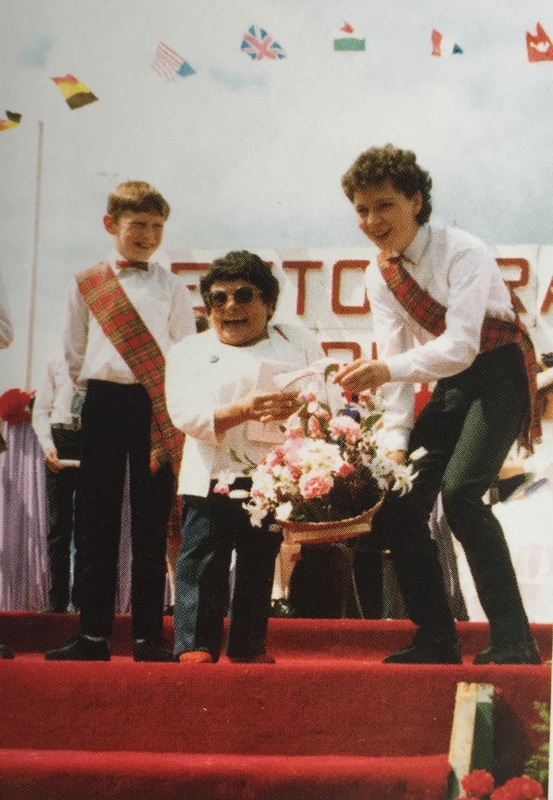Newtongrange: A History
Our Village Through The Years
Although nowadays coal conjures up adverse environmental images of slag heaps, ash, smog and dust, or down-beat social images of strikes, picketing, poverty and crippling health conditions, in it's day, coal was at the core of the industrial revolution. It was the energy that powered the nation and fundamental to our everyday life in Newtongrange, including through employment directly or indirectly. Thus, coal fortified our quality of life. Conversely men, women and children lived and died to hew for coal to support their families and their community. Newton Grange (as it was previously written) was created to support the production of coal. Newtongrange, or Nitten, aka Nitten by the Bing, as it became fondly known, was the largest mining village in Scotland with the sinking of The Lady Victoria Colliery 1895; later, after it's closure, to become, The Scottish National Mining Museum in 1984 almost 90 years later. The Lady was connected by an underground seam to another pit in Newtongrange, Lingerwood Colliery which was sunk almost one hundred years before in 1798; both collieries were owned by The Lothian Coal Company along with severally others locally. Working down the mines was a hard and dirty job. You were always under the threat of a roof fall, or another accident. Families lived in dread of the warning siren that would sound when a serious accident occurred. Taking up an instrument to play in a colliery brass band or pipe band (sponsored by the coal owners) was a release from the drudgery and darkness of the mines. Times were hard and miners were low paid and they had to fight for their pay and conditions. After one successful strike for more wages in 1912, the local miner's committee agreed to give up one day's wage per week to provide for a children's day and the following year, on 10th July 1913, Nitten Gala began. The Gala was a great success and many villagers turned out for the procession to Victoria Park, home of Newtongrange Star Football Club, where sporting activities and a flower show took place. The parade was led by the Lothian Silver Band and a banner emblazoned with "Newtongrange Children's Gala", was carried at the front of the procession. Thus Nitten community was bound not just by it's geographical links and it's industrial lifestyle but also by a family event that brought joy, pride and a sense of belonging, to it's whole populations and in particular, to it's children.
The following year again, the procession started at the Public Park and passed through the streets of Newtongrange. This time, the streets were lined with spectators as they made their way to Victoria Park for refreshments, sports and flower displays - the humble beginnings of what was to become a tradition spanning one hundred years. There was no King or Queen and hence no crowning ceremony or pageant at this time, nonetheless it was a day of great enjoyment for all. Newtongrange village was extended with Pit Houses built around the Public Park. The houses formed a square around the park and thus were named "The Square" in 1914.
Due to an outbreak of war (WW1), the galas following 1914 were curtailed until 1923. In 1915, the Newbattle School Board agreed that pupils would sit an examination for a pupil-dux with consideration for the female dux to be crowned Queen of the Gala at any future Galadays.
Pit Ponies went underground for the last time in 1923 and that year saw the resumption of the Gala. Emma Quinto became the Pupil-Dux and she was crowned Queen on 2nd August 1923. In preparation for the Gala, two local women, when on a trip to the Globe Train (a trip taken once a week by communities to buy cut-price foodstuffs) they took the opportunity to pop into a second hand shop in search of ceremonial items for the gala and bought what they thought was a fitting chair for the crowning ceremony. Everyone rallied to make the gala a success. A robe and a crown was donated by local businessmen. The Lothian Coal Company built a stage and the evert was not only a great success, but a real spectacle which lifted the village's spirits post war. All donated items continued to be used for a considerable amount of years. The crowning ceremony took place in the Square Park, after which, the procession marched on to Newbattle Home Farm Park for the program of sports, races and a flower show. Children from the age of two years upwards were given a bag of cakes, a hot pie and milk.
The local school was Newbattle Public School and was built in 1893. The school was extended in 1907 and was situated in the corner of Gardiner Place and Mansfield Road (neither as yet built). The head teacher and his staff helped to organise the gala and attended the day's events. This school later became both a secondary school as well as a primary school. After it's closure, it was converted into Esk Valley College providing pre-apprenticeship courses in mathematics and the trades such as; welding, fitting and turning. Later it was to become a clothing factory but was known locally as "The Nicker" factory before it was extensively damaged by fire. What was left of the building, later became Newbattle Community Centre.
Further housing was built at Lothian Terrace in 1924 and Victoria Park and it's pavilion were opened in the same year. St Andrews RC Primary School, a new Roman Catholic school was opened at Newtonloan Toll to serve both Newtongrange and Gorebridge. The 1924 gala crowning ceremony was preformed in the Square Park but this time, the gala activities took place in Roans Dyke Park. Each child was given pie, milk and a "well-filled" bag of fruit. Newtongrange Primary School was built in 1925 to relieve overcrowding at Newbattle Public School which was later renamed Newbattle Junior Secondary School, but Newbattle continued as both a primary school as well as a secondary school. Again, the crowning ceremony was preformed in the Square Park and the activities held in Roans Dyke Park. In 1926, Mr Mungo Mackay, the General Manager of the Lothian Coal Company and President of the Gala Committee opened the Gala proceedings. That year, a new public park known as "Welfare Park", the first of it's kind Scotland was opened by Viscount Chelmsford. The park was paid for by the miners welfare fund ( money donated directly from miners wages) hence-why it was names Newtongrange Welfare Park. The Welfare Park would eventually become the regular venue for the gala crowning ceremony, activities and entertainment. 1926 was also significant because of the general strike in support of mineworkers who had had an enforced pay cut creating real hardship for miners and their families whose slogan was "not a minute on the day, not a penny of the day". The strike began on 3rd March and lasted 10 days. Dockers, printers, railwaymen, power and transport workers came out in support of the miners. The government of the day enlisted the help of the army to keep essential services and to get food supplies through. Strikebreakers and volunteers provided a skeleton workforce for buses, trains and delivery vehicles.
The seventh gala event held in 1927 was proclaimed a success on different levels not least that youngsters were 'striving to occupy the exalted position' so from an academic point of view it had created some enthusiasm in the class room. In 1928, Newtongrange Parish Church Council ceased and in 1932 baths and kitchens were installed in the pit houses.
Newtongrange Star (founded in 1890) won the Scottish Junior Cup 1929-1930; the club went on to win many more trophies and titles. The gala was now considered to be a 'red letter' day (the term originated from events being marked on calendars in red ink because of their significance.
Subsequent galas from 1928 to 1937 continued to follow much he same format, only being interrupted briefly in 1931 when the crowning ceremony was temporarily preformed in Victoria Park but returning to the Square Park but returning to the Square Park in 1932. The first council house scheme was built in Gardiner's Place in 1933 and also that year, Allan's Garage at the Auld Toll began.
In the same year, the first 'talkies' at the Picture Palace also took place. in 1936 Galadean was built. Newbattle and District Welfare Pipe Band was founded in 1937.
The following year again, the procession started at the Public Park and passed through the streets of Newtongrange. This time, the streets were lined with spectators as they made their way to Victoria Park for refreshments, sports and flower displays - the humble beginnings of what was to become a tradition spanning one hundred years. There was no King or Queen and hence no crowning ceremony or pageant at this time, nonetheless it was a day of great enjoyment for all. Newtongrange village was extended with Pit Houses built around the Public Park. The houses formed a square around the park and thus were named "The Square" in 1914.
Due to an outbreak of war (WW1), the galas following 1914 were curtailed until 1923. In 1915, the Newbattle School Board agreed that pupils would sit an examination for a pupil-dux with consideration for the female dux to be crowned Queen of the Gala at any future Galadays.
Pit Ponies went underground for the last time in 1923 and that year saw the resumption of the Gala. Emma Quinto became the Pupil-Dux and she was crowned Queen on 2nd August 1923. In preparation for the Gala, two local women, when on a trip to the Globe Train (a trip taken once a week by communities to buy cut-price foodstuffs) they took the opportunity to pop into a second hand shop in search of ceremonial items for the gala and bought what they thought was a fitting chair for the crowning ceremony. Everyone rallied to make the gala a success. A robe and a crown was donated by local businessmen. The Lothian Coal Company built a stage and the evert was not only a great success, but a real spectacle which lifted the village's spirits post war. All donated items continued to be used for a considerable amount of years. The crowning ceremony took place in the Square Park, after which, the procession marched on to Newbattle Home Farm Park for the program of sports, races and a flower show. Children from the age of two years upwards were given a bag of cakes, a hot pie and milk.
The local school was Newbattle Public School and was built in 1893. The school was extended in 1907 and was situated in the corner of Gardiner Place and Mansfield Road (neither as yet built). The head teacher and his staff helped to organise the gala and attended the day's events. This school later became both a secondary school as well as a primary school. After it's closure, it was converted into Esk Valley College providing pre-apprenticeship courses in mathematics and the trades such as; welding, fitting and turning. Later it was to become a clothing factory but was known locally as "The Nicker" factory before it was extensively damaged by fire. What was left of the building, later became Newbattle Community Centre.
Further housing was built at Lothian Terrace in 1924 and Victoria Park and it's pavilion were opened in the same year. St Andrews RC Primary School, a new Roman Catholic school was opened at Newtonloan Toll to serve both Newtongrange and Gorebridge. The 1924 gala crowning ceremony was preformed in the Square Park but this time, the gala activities took place in Roans Dyke Park. Each child was given pie, milk and a "well-filled" bag of fruit. Newtongrange Primary School was built in 1925 to relieve overcrowding at Newbattle Public School which was later renamed Newbattle Junior Secondary School, but Newbattle continued as both a primary school as well as a secondary school. Again, the crowning ceremony was preformed in the Square Park and the activities held in Roans Dyke Park. In 1926, Mr Mungo Mackay, the General Manager of the Lothian Coal Company and President of the Gala Committee opened the Gala proceedings. That year, a new public park known as "Welfare Park", the first of it's kind Scotland was opened by Viscount Chelmsford. The park was paid for by the miners welfare fund ( money donated directly from miners wages) hence-why it was names Newtongrange Welfare Park. The Welfare Park would eventually become the regular venue for the gala crowning ceremony, activities and entertainment. 1926 was also significant because of the general strike in support of mineworkers who had had an enforced pay cut creating real hardship for miners and their families whose slogan was "not a minute on the day, not a penny of the day". The strike began on 3rd March and lasted 10 days. Dockers, printers, railwaymen, power and transport workers came out in support of the miners. The government of the day enlisted the help of the army to keep essential services and to get food supplies through. Strikebreakers and volunteers provided a skeleton workforce for buses, trains and delivery vehicles.
The seventh gala event held in 1927 was proclaimed a success on different levels not least that youngsters were 'striving to occupy the exalted position' so from an academic point of view it had created some enthusiasm in the class room. In 1928, Newtongrange Parish Church Council ceased and in 1932 baths and kitchens were installed in the pit houses.
Newtongrange Star (founded in 1890) won the Scottish Junior Cup 1929-1930; the club went on to win many more trophies and titles. The gala was now considered to be a 'red letter' day (the term originated from events being marked on calendars in red ink because of their significance.
Subsequent galas from 1928 to 1937 continued to follow much he same format, only being interrupted briefly in 1931 when the crowning ceremony was temporarily preformed in Victoria Park but returning to the Square Park but returning to the Square Park in 1932. The first council house scheme was built in Gardiner's Place in 1933 and also that year, Allan's Garage at the Auld Toll began.
In the same year, the first 'talkies' at the Picture Palace also took place. in 1936 Galadean was built. Newbattle and District Welfare Pipe Band was founded in 1937.
A TRIP DOWN MEMORY LANE
I first became associated with the Gala through my friendship with the late Annie Melrose who was Chairman until 1979. I have many happy memories from the early ‘70s’. I remember helping friends organise outfits for the Fancy Dress Parade - I can still see the late Archie Neilson in his ‘Cooperman’ outfit, collecting can in hand, holding villagers to ransom along the route of the parade. Nobody dared refuse and Archie always collected a lot of money for gala funds! Archie’s family donated a shield in his memory and this is awarded each year to the overall winner of the Fancy Dress Contest.
Fundraising has always played a major part in our Committee’s activities. As well as raising funds for the Gala, we have also raised money for other children’s charities or local appeals. Over the years we have walked from Newtongrange to Edinburgh dressed as clowns collecting money en route, jumped out of ‘planes’, abseiled from a great height, climbed Burma bridges and other obstacles - all in the name of fundraising. As a special sponsored event for our 1993 80th Anniversary Celebrations, a ‘squadron’ of committee members and friends took to the air over East Lothian in microlight planes. As well as raising much needed money, these events have provided much entertainment over the years!
We have had many laughs behind the scenes at the Gala. We have a number of unseen hard-working committee members and friends who are on ‘Cookhouse Duties’ preparing meals and refreshments in the Church Hall throughout the Gala. ‘Kitchen’ duty begins at 6am on the Gala Day preparing the day’s catering, tables being set, cleared and re-laid in no time at all. I can remember one occasion when we had a gymnastics team appearing at the Gala. During the afternoon, when the Church Hall was at its busiest, we heard a steady pounding. Margaret Cairns, one of our Catering Team helpers who, at the time, was serving orange juice from giant kettles, popped out the door to see what was happening and found herself in the centre of the team of gymnasts who were jogging back, en masse, to the hall. One of our amusing memories is the picture of Margaret, usually so quiet and retiring, caught up in the group, jogging into the hall; under escort, holding the kettles above her head.
On another occasion the laugh was on me. It had been arranged for me to take part in one of the Blue Arrows Motor Cycle Display Team’s stunts called “The Zipper” in which some of the team members lie face down on the ground, in one long line. The line splits to form two sides when two riders mount the ramp and jump the bikes between the lines. I was put in position at the top of this line and was under instruction not to move until ordered to do so by the Team Leader. I was so excited as I anxiously awaited my orders. I heard the bikes revving up and I waited - I heard a shout in the distance but it was not for me. I waited - and waited - and waited - until I felt a tap on my shoulder. When I stood up I found the crowd around the arena helpless with laughter and I couldn’t understand what had happened. Then I realised the Team had moved to the other end of the arena to do the stunt by themselves and I was left on my own, lying face down, in the middle of the arena. The Blue Arrows had planned this joke and, I have to admit, I fell for it hook, line and sinker!! We all had a good laugh after the display.
JANETTE STEWART
(Chair, Newtongrange Galaday – 1990s)
I first became associated with the Gala through my friendship with the late Annie Melrose who was Chairman until 1979. I have many happy memories from the early ‘70s’. I remember helping friends organise outfits for the Fancy Dress Parade - I can still see the late Archie Neilson in his ‘Cooperman’ outfit, collecting can in hand, holding villagers to ransom along the route of the parade. Nobody dared refuse and Archie always collected a lot of money for gala funds! Archie’s family donated a shield in his memory and this is awarded each year to the overall winner of the Fancy Dress Contest.
Fundraising has always played a major part in our Committee’s activities. As well as raising funds for the Gala, we have also raised money for other children’s charities or local appeals. Over the years we have walked from Newtongrange to Edinburgh dressed as clowns collecting money en route, jumped out of ‘planes’, abseiled from a great height, climbed Burma bridges and other obstacles - all in the name of fundraising. As a special sponsored event for our 1993 80th Anniversary Celebrations, a ‘squadron’ of committee members and friends took to the air over East Lothian in microlight planes. As well as raising much needed money, these events have provided much entertainment over the years!
We have had many laughs behind the scenes at the Gala. We have a number of unseen hard-working committee members and friends who are on ‘Cookhouse Duties’ preparing meals and refreshments in the Church Hall throughout the Gala. ‘Kitchen’ duty begins at 6am on the Gala Day preparing the day’s catering, tables being set, cleared and re-laid in no time at all. I can remember one occasion when we had a gymnastics team appearing at the Gala. During the afternoon, when the Church Hall was at its busiest, we heard a steady pounding. Margaret Cairns, one of our Catering Team helpers who, at the time, was serving orange juice from giant kettles, popped out the door to see what was happening and found herself in the centre of the team of gymnasts who were jogging back, en masse, to the hall. One of our amusing memories is the picture of Margaret, usually so quiet and retiring, caught up in the group, jogging into the hall; under escort, holding the kettles above her head.
On another occasion the laugh was on me. It had been arranged for me to take part in one of the Blue Arrows Motor Cycle Display Team’s stunts called “The Zipper” in which some of the team members lie face down on the ground, in one long line. The line splits to form two sides when two riders mount the ramp and jump the bikes between the lines. I was put in position at the top of this line and was under instruction not to move until ordered to do so by the Team Leader. I was so excited as I anxiously awaited my orders. I heard the bikes revving up and I waited - I heard a shout in the distance but it was not for me. I waited - and waited - and waited - until I felt a tap on my shoulder. When I stood up I found the crowd around the arena helpless with laughter and I couldn’t understand what had happened. Then I realised the Team had moved to the other end of the arena to do the stunt by themselves and I was left on my own, lying face down, in the middle of the arena. The Blue Arrows had planned this joke and, I have to admit, I fell for it hook, line and sinker!! We all had a good laugh after the display.
JANETTE STEWART
(Chair, Newtongrange Galaday – 1990s)

© COPYRIGHT 2014-2023. ALL RIGHTS RESERVED
REGISTERED CHARITY NUMBER: SC016761
Website Designed & Maintained By Connor Wright
.


